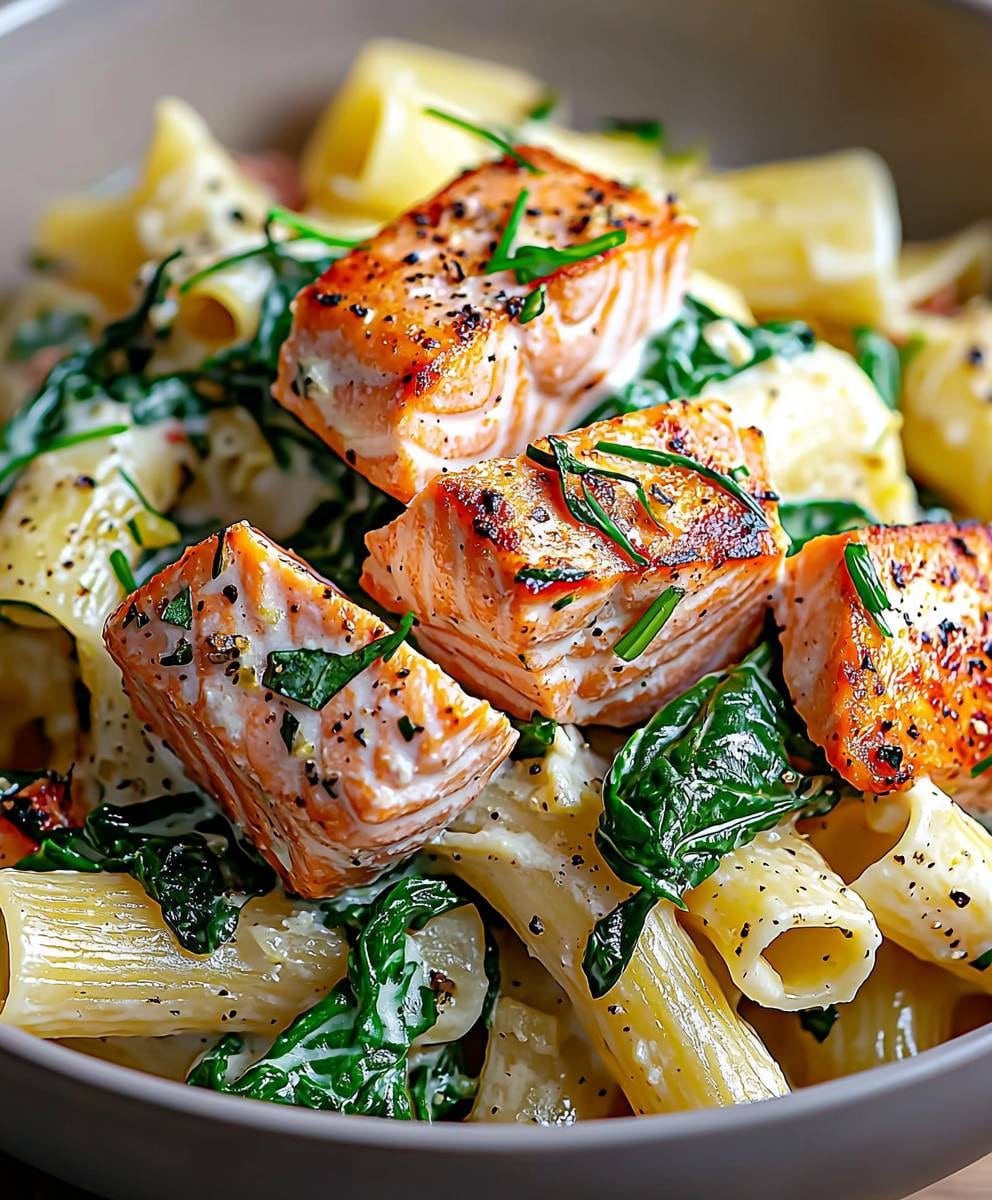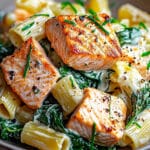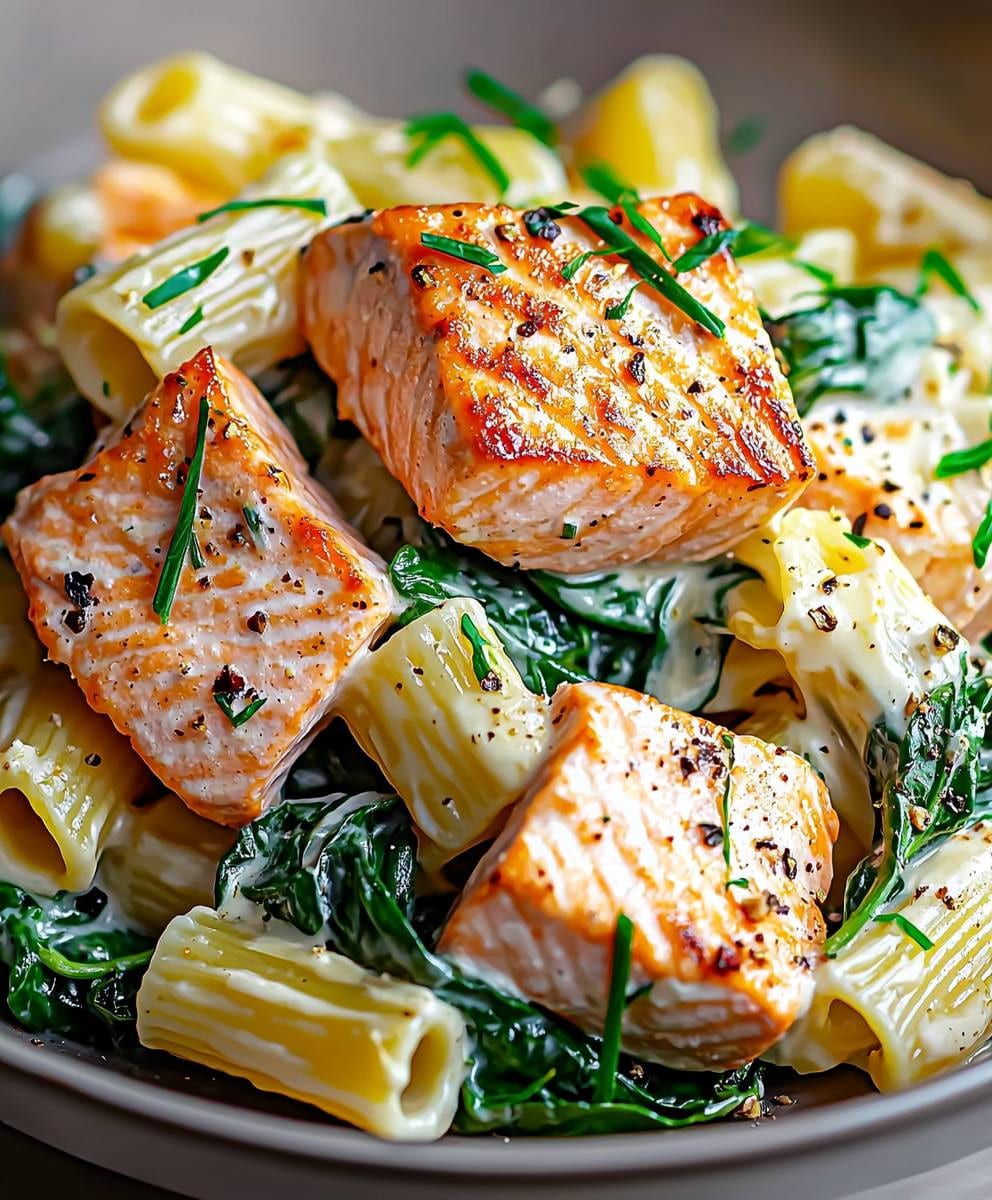Salmon Spinach Pasta Dish is a fast and healthy meal combining tender fish with a creamy, rich sauce. This fettuccine recipe is simple to make and perfect for busy weeknights, offering great nutrition for your family.
Salmon Spinach Pasta Dish is the perfect answer for a nutritious and satisfying meal. You will love how quickly this rich, creamy dish comes together using just a few simple ingredients. This recipe successfully pairs tender, flaky salmon with fresh spinach and a luxurious garlic-parmesan cream sauce. It is an impressive dish that manages to feel both indulgent and healthy, fitting perfectly into your weeknight rotation.
Key Takeaways
- Prep and cook time is just 35 minutes, making it very fast.
- The dish features healthy fats from salmon and fiber from spinach.
- A creamy garlic-parmesan sauce binds the fresh ingredients together.
- It’s versatile; you can easily swap pasta shapes or add other vegetables.

You can make a delicious Salmon Spinach Pasta Dish by cooking your pasta until al dente, flaking seasoned salmon in a skillet, and then combining the pasta with a creamy sauce made from heavy cream, garlic, and Parmesan cheese, and finally folding in the salmon and wilted spinach.
Mastering the Creamy Sauce for Your Salmon Spinach Pasta
The foundation of this dish is a sauce that is both simple and incredibly flavorful. You will create the base by sautéing minced garlic, which is essential for that aromatic depth of flavor. Do not rush this step; allow the garlic to become fragrant but not burned for the best results in your sauce.
The Role of Heavy Cream and Parmesan
Heavy cream provides the rich texture and body that defines this creamy pasta dish. When you add the cream, be sure the heat is low to prevent scorching or separating the sauce. Gradually stirring in Parmesan cheese allows it to melt smoothly, thickening the sauce beautifully. Always use freshly grated Parmesan for superior flavor and meltability in this dish.
Flavor Boosters: Lemon Zest and Red Pepper Flakes
Adding lemon zest brings a bright, fresh acidity that cuts through the creaminess, balancing the rich flavors. A small amount of lemon juice further enhances this zest and lightens the sauce. You can include red pepper flakes for a subtle, warming heat that provides a delightful complexity to the flavor profile, making the meal more dynamic.
Preparing the Star: Flaky Salmon Fillet
Seasoning the salmon correctly is the first step to ensuring a flavorful outcome for your meal. You should lightly season the fillet with salt and pepper, adding a splash of lemon juice before it hits the skillet. This initial seasoning penetrates the fish as it cooks, guaranteeing delicious flavor in every bite you take.
The Quick Cooking Process for Perfection
You should cook the salmon in olive oil over medium heat for about four to five minutes on each side. The goal is to cook it until it is opaque and flakes easily with a fork, showing it is cooked all the way through. After removing the salmon, let it cool slightly before flaking it into the skillet, which helps it stay intact.
How to Achieve Ideal Salmon Flakiness
To keep the salmon tender, you must avoid overcooking it in the skillet. Once cooked, gently flaking it into bite-sized pieces ensures that it disperses nicely throughout the pasta dish. You should be gentle when folding it into the final sauce to prevent it from completely disintegrating into the pasta, maintaining its texture.
Incorporating Fresh Spinach and Garlic Aromatics
The initial aroma of the dish comes from quickly sautéing the minced garlic in the same skillet used for the salmon. This step is vital for building a deep, savory foundation for your sauce base. Be watchful during this step, as garlic can burn quickly, turning bitter and ruining the flavor of the entire pasta dish.
Wilt the Spinach Just Before the Sauce
You will add the four cups of roughly chopped spinach immediately after the garlic becomes fragrant. It only takes two to three minutes for the spinach to fully wilt down in the warm skillet, reducing its volume significantly. This short cooking time helps preserve the spinach’s bright green color and some of its nutritional value for you.
Cooking Pasta to Perfection: Al Dente is Key
The texture of the pasta greatly affects the overall quality of your Salmon Spinach Pasta Dish. You must cook the fettuccine or linguine until it is perfectly al dente, meaning “to the tooth” in Italian, giving it a slight bite. Follow the package instructions closely, as typically this takes about eight to ten minutes of boiling time.
The Importance of Reserved Pasta Water
Before you drain the pasta, make sure to reserve about one cup of the starchy cooking water. This reserved water is your secret weapon for achieving the perfect sauce consistency later on. The starch in the water helps the sauce cling better to the pasta strands, making a more luxurious and professional finish for you to enjoy.
Final Assembly: Tossing and Serving the Dish
Once your pasta is drained and lightly tossed with olive oil, add it directly to the creamy sauce in the skillet. You must toss it gently but thoroughly to ensure every strand is coated with the rich garlic-Parmesan mixture. This ensures every bite of your Salmon Spinach Pasta Dish is equally flavorful and satisfying.
Gently Folding in the Flaked Salmon
After coating the pasta, you should gently fold the flaked salmon into the skillet. Remember to keep some of the salmon chunks intact; you do not want to break them down too much. The final fold should distribute the fish evenly without mashing it, preserving its tender texture throughout the dish.
Adjusting Consistency with Pasta Water
If the sauce seems too thick at this point, you can gradually add a tablespoon of the reserved pasta water at a time. The water will thin the sauce while also binding it to the pasta, reaching your desired creamy consistency. You will only need to add what is necessary to achieve a velvety texture for your dish.
Salmon Spinach Pasta Dish: Variations and Customizations
While the classic recipe is wonderful, you have many options for personalizing this pasta dish to suit your taste. You can substitute the salmon with other proteins like grilled chicken or even shrimp for a different seafood profile. Changing the protein keeps the recipe fresh and allows you to use ingredients you already have on hand, which is helpful.
Alternative Pasta and Vegetable Choices
You can easily swap out the fettuccine for other pasta shapes like penne, fusilli, or farfalle if you prefer a shorter noodle. For added nutrition and flavor, consider stirring in some cherry tomatoes, chopped asparagus, or peas along with the spinach. These vegetable additions increase the complexity of the meal, offering you a brighter, fresher taste.
Nutritional Benefits of Salmon and Spinach
Choosing this Salmon Spinach Pasta Dish provides you with significant health advantages in addition to being delicious. Salmon is an excellent source of omega-3 fatty acids, which are widely known for supporting brain health and reducing inflammation. You are choosing a powerhouse protein that is good for your heart and overall well-being.
Spinach: A Boost of Vitamins and Minerals
Spinach contributes a healthy dose of vitamins K and A, as well as crucial antioxidants, making it a very nutritious green. Even after wilting in the sauce, the spinach retains many of its minerals and fiber content. You are sneakily adding a great source of iron and folate to your meal with this simple inclusion.
Serving Suggestions and Quick Wine Pairings
You should serve the creamy Salmon Spinach Pasta Dish immediately after finishing to enjoy its best texture and warmth. Transfer it directly to warm bowls and garnish generously with fresh, chopped parsley for a pop of color and herbaceous freshness. This final touch makes the presentation much more appealing and professional for your guests.
The Perfect Accompaniments for a Complete Meal
Pairing this rich pasta with a simple side salad tossed in a light vinaigrette provides a nice contrast to the creamy sauce. A dry white wine, like a Sauvignon Blanc or an unoaked Chardonnay, complements the salmon and the creamy, garlicky sauce beautifully. For more inspiration, you can check out my latest dinner recipes here.
Leftovers and Storage for Salmon Spinach Pasta Dish
Storing any remaining Salmon Spinach Pasta Dish properly ensures you can enjoy it later. You should place the leftovers in an airtight container and refrigerate them as soon as they have cooled down. The pasta is best consumed within two days to maintain the freshest flavor and quality.
Tips for Reheating Without Drying Out
When you are ready to reheat, use a skillet on the stovetop over low heat instead of the microwave. Adding a splash of milk or a tiny bit of cream helps to revive the sauce’s creaminess, which may have thickened overnight. Gently stir the pasta until it is heated through, making sure not to overcook the salmon pieces.
Follow my Pinterest and Instagram for more recipe ideas: Pinterest and Instagram.
Troubleshooting Common Salmon Spinach Pasta Issues
A common issue is a sauce that is too thin, which you can easily fix by simmering it for a few extra minutes on low heat. If simmering does not help, dissolve a teaspoon of cornstarch in a tablespoon of cold water and slowly stir it into the sauce to thicken it quickly. You will find that adding more Parmesan cheese also helps in creating a desirable thickness.
Preventing Salmon from Becoming Too Dry
If your salmon is prone to dryness, be mindful of the initial cooking time in the skillet and remove it just before it is fully cooked. Remember that the residual heat will continue to cook the fish slightly even after it is taken off the burner. When folding it into the sauce, the liquid helps keep the pieces moist and flavorful for your enjoyment.
Scaling the Salmon Spinach Pasta Dish Recipe
You may easily double or triple this Salmon Spinach Pasta Dish recipe to feed a larger group or for meal prepping. If you are scaling up, use a very large, deep skillet or a pot to ensure you have enough space for tossing the pasta and sauce effectively. You must also adjust the cooking times slightly for the salmon if you are cooking multiple fillets at once.
Adjusting Ingredients for Smaller Servings
For a smaller serving of two, you can simply halve all the ingredients listed in the recipe instructions. Remember that the cooking times for the pasta and salmon will remain roughly the same, but the sauce will thicken faster. See this post on how to adjust cooking times for a stew when scaling recipes.
Conclusion
Salmon Spinach Pasta Dish offers you a perfect blend of rich flavor, speed, and health benefits in one satisfying bowl. You have learned how to create a velvety, garlicky cream sauce and incorporate tender, flaky salmon with fresh spinach. This recipe is versatile and straightforward, allowing you to have a beautiful meal ready in under forty minutes. It’s a wonderful choice for an effortless yet elegant weeknight dinner you will want to make repeatedly.
By following these steps, you can confidently prepare this creamy and flavorful Salmon Spinach Pasta Dish for your family and guests. You now have a reliable, go-to recipe that provides both comfort and excellent nutrition in a convenient way. Enjoy the process of creating this fantastic meal and the delighted reactions from anyone you serve it to.
Print
Salmon Spinach Pasta Dish: A Delicious and Nutritious Recipe to Try Today
- Total Time: 35 minutes
Description
Enjoy a delightful creamy salmon and spinach pasta, featuring fettuccine or linguine in a rich garlic and Parmesan sauce. This quick and satisfying dish is perfect for both weeknight dinners and special occasions.
Ingredients
Main Ingredients
- 8 ounces of pasta (fettuccine or linguine)
- 2 tablespoons olive oil
- 2 cloves garlic, minced
- 1 pound fresh salmon fillet, skin removed
- 4 cups fresh spinach, washed and roughly chopped
- 1 cup heavy cream
- 1/2 cup grated Parmesan cheese
- 1 teaspoon lemon zest
- 2 tablespoons fresh lemon juice
- Salt and pepper to taste
- 1/4 teaspoon red pepper flakes (optional)
- Fresh parsley, chopped (for garnish)
Instructions
- Start by bringing a large pot of salted water to a boil.
- Add the pasta and cook according to package instructions until al dente, about 8-10 minutes. Stir occasionally.
- Before draining, reserve about 1 cup of the pasta cooking water.
- Drain the pasta and toss with a little olive oil to prevent sticking.
- Season the salmon fillet with salt, pepper, and a sprinkle of lemon juice.
- In a large skillet, heat 2 tablespoons of olive oil over medium heat. Cook the salmon for 4-5 minutes on each side until cooked through.
- Remove the salmon from the skillet, let it cool, then flake it into bite-sized pieces.
- In the same skillet, add minced garlic and sauté for about 30 seconds until fragrant.
- Add chopped spinach and cook for 2-3 minutes until wilted.
- Reduce heat to low and pour in the heavy cream, stirring to combine.
- Gradually add grated Parmesan, stirring until melted and the sauce thickens.
- Add lemon zest, lemon juice, and red pepper flakes (if using). Simmer for another 2-3 minutes, adjusting seasoning with salt and pepper.
- Add the drained pasta to the skillet and toss to coat with the sauce.
- Gently fold in the flaked salmon, keeping some chunks intact.
- If needed, add reserved pasta water a tablespoon at a time until desired consistency is reached.
- Serve the salmon spinach pasta in bowls or on plates.
- Sprinkle with fresh parsley for added freshness.
- Serve immediately and enjoy! Leftovers can be stored in an airtight container in the fridge for up to 2 days.
Notes
Pasta Choices:
Feel free to use any pasta shape you prefer. Whole wheat or gluten-free pasta can also be used for a healthier option.
Vegetable Additions:
Consider adding other vegetables like cherry tomatoes or asparagus for extra flavor and nutrition.
Nutrition
- Serving Size: 4 servings
Keywords: salmon pasta, spinach, creamy, weeknight dinner

